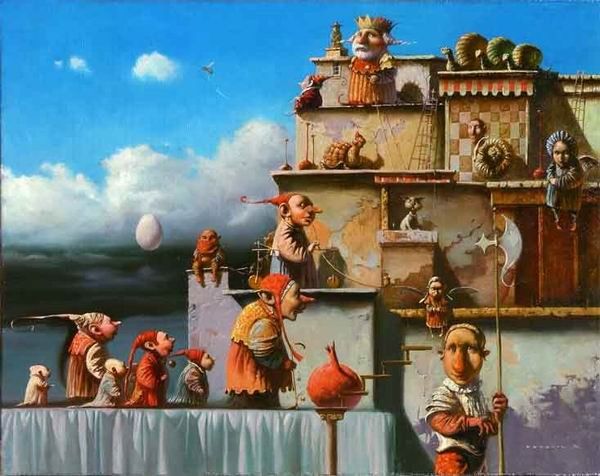
Chess Center of Gravity, Part 2
CoG = WHAT MATTERS MOST IN POSITION
Last time we identified one critical skill chess masters possess that provides a huge competitive edge over amateurs: it is Center of Gravity, a concept developed by the Prussian military theorist Carl von Clausewitz that applies in all situations of conflict where two or more parties battle.
In the same way that CoG is a useful reference point for calculations in physics, locating CoG in the games of strategy helps us grasp the essence of situation, orient ourselves and take the right direction during confrontation. It saves us time and calculation effort.
.
Identifying CoG is First Stage of Thinking Process
We like to say that chess promotes critical thinking. So what is critical thinking anyway?
It is a three-step process requiring that we first understand situation we are in, before we come to a conclusion on what to do next, and ultimately take the right course of action. It gives us a framework to think in, in chess, or any field of life for that matter. Chess seems a perfect paradigm of effective thinking and a powerful tool to practice it.
Center of Gravity should be the product of the first step in the thinking process. When we face position in front of us, we should ask ourselves questions (like What is CoG here?, What matters most in this position?, What is the key to this situation?) to clarify the issue. As a matter of fact, the single reason why so many undertakings and decisions fail is that situation or objectives are not clear in the first place.
Clarity is essential in the first stage of the 3-step thinking process (as compared to later conclusion and decision-making phases) when thinking effectively. Without it, the later stages become increasingly more costly in terms of time and effort with less than expected results.
.
Practicing CoG
This is Bent Larsen – Aleksandar Matanovic, Zagreb 1965 (White to move).
Our task is to identify the CoG in position.

Let’s try to first bring some clarity to this position. This will give us ideas where we should look for CoG.
White pieces are more active. They are all ideally placed. Look at the knights: they occupy perfect attacking posts close to the enemy headquarters, ready to strike at any moment. As a temporary setback, the d4-knight is closing the bishop’s diagonal at the moment. But that can be fixed. The c4-rook is on an open file and is challenged by the black counterpart that has just moved Re8-c8 fearing White’s strong Qe3-c3. Yes, the queen is also ideally positioned. She may go to c3 on the long diagonal and behind the rook on an open file, creating two powerful batteries (Bb2-Qc3 and Qc3-Rc4), but she may also move to the K-side quickly along the c1-h6 diagonal. So every member of the White’s army is doing good job.
Compare now with Black’s army. You can immediately sense that they aren’t doing as well. There is no target for them to “glue their action together,” so they look pretty disorganized. They don’t seem to have any useful mission to get on with (CoG cannot be found for them!), and on top of that, their defensive capabilities seem reduced as they are placed a little away from their supreme commander’s post towards which a brutal assault may be currently brewing.
So what may be the most distinctive capability available to White to help press home advantage? (remember that military definition of CoG? a characteristic, capability, or locality that enables one’s own forces to accomplish their objectives.)
Larsen saw the long diagonal, the highway toward g7, as the main asset and the key capability his pieces possess in this position – it was a clear CoG for him. CoG is like the backbone of position. It gives White the idea of what to do next:
1. Nxe6 Rxc4?
2. Nh6+
1…f6 seemed to be to only move to play on, but that would have left Black pawn down with a “miserable position” (Larsen). Obviously, on 1…fxe6, 2.Qc3 would have followed.
The Black king resigns, just two moves after our initial position, 1-0.
.
Piece Harmony
Did you see how all White’s pieces were drawing their energy from the contact with the long diagonal, the CoG in position?
– the bishop and the d4-Knight play in sync as (after 1.Nxe6) the long diagonal opens up, when g7 is double-attacked
– the white Queen uses c3 (in the 1…fxe6 2.Qc3 line) to create a powerful double battery, the primary one firing along the long diagonal
– the g4-Knight is sacked to help its Queen reach h6, which in turn establishes contact with the key square g7
This is an exemplary coordination of pieces working together in a most harmonious way (“the main principle throughout,” Capablanca). The full value of individual capabilities of pieces emerges only when they work as a team toward a viable objective.
CoG makes the most efficient use of available resources, attention and time. It is the glue of position. It gives strength and cohesion to it by creating the essential advantage.
* * *
Next time we are going to familiarize ourselves with the theory of the main characteristic of position as per IM Vladimir Vukovic (the author of the Art of Attack in Chess classic) from his Introduction to Chess, Zagreb 1947. Although the ability to locate CoG takes a lot of time to develop, Vukovic presents the concept as the first chapter in the book's Positional section. Obviously, he thought it a very important thing for the beginner to adopt early as part of his/her winning chess mindset!
